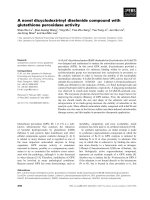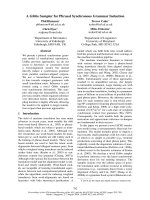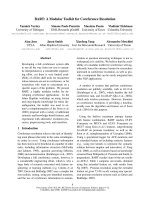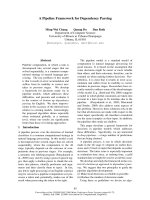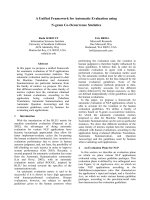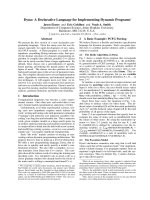Báo cáo khoa học: "A The Molecular Adsorbent Recirculating System (MARS®) in the intensive care unit: a rescue therapy for patients with hepatic failure" pdf
Bạn đang xem bản rút gọn của tài liệu. Xem và tải ngay bản đầy đủ của tài liệu tại đây (42.95 KB, 3 trang )
Page 1 of 3
(page number not for citation purposes)
Available online />Abstract
Treatment in the intensive care unit of patients with end-stage liver
disease has been limited. Liver transplantation has been a major
improvement in this and has become standard in the management
of these patients. However, many patients die awaiting liver
transplantation, mainly due to the scarcity of organ donors.
Conventional hemodialysis techniques have little or no effect on
liver detoxification and do not improve the prognosis of these
patients. In patients with acute hepatic failure, the majority of
endogenous toxins leading to organ failure and accumulating in the
blood are bound to albumin; therefore, the concept of albumin
dialysis is of major interest. To date, the most widely developed
system has been the Molecular Adsorbent Recirculating System
(MARS
®
), which is based on the selective removal of albumin-
bound toxins from the blood. MARS
®
enables simultaneous liver
and kidney detoxification, improving the patient's clinical condition.
It is a major improvement in the management of patients with
hepatic failure that could permit, when appropriately indicated,
recovery from an acute episode and enhance the chances of
survival while waiting for an available organ donor.
Introduction
During the past decades, few therapeutic measures have
been developed for the treatment of patients with end-stage
liver disease. Despite a great improvement in the field of
transplantation, the mortality in patients developing hepatic
failure remains very high and many patients die while awaiting
liver transplantation. In recent years, a major interest has been
the replacement of the liver by extracorporeal systems that
may provide a lifeline until a spontaneous recovery of the liver
or until an appropriate donor is available. Many non-biological
liver support therapies based on detoxification of the patient’s
blood have been developed. These include standard or high-
flux hemodialysis, continuous veno-venous hemofiltration or
hemodiafiltration, charcoal perfusion, hemadsorption with
non-biological adsorbents and plasma or blood exchange
[1-4]. To date, the most widely developed system has been
the Molecular Adsorbent Recirculating System (MARS
®
),
which uses albumin dialysis to mainly replace the
detoxification function of the liver. Two other systems using a
similar approach have been developed recently, the
Prometheus
®
and the Single-Pass Albumin Dialysis (SPAD
®
)
systems; few patients have been treated with these systems
to date, but their results could be promising [5,6].
Molecular Adsorbent Recirculating System
MARS
®
is a liver support system that uses an albumin-
enriched dialysate to facilitate the removal of albumin-bound
toxins. The system has three different fluid compartments: a
blood circuit, a circuit containing 600 ml of 20% human
albumin with a charcoal column and an anion exchange resin
column and a dialysate circuit [7]. MARS
®
requires a
standard dialysis machine or a continuous veno-venous
hemodiafiltration device (CCVVHD) to control the blood and
dialysate circuits.
MARS
®
has been used in the intensive care unit in most
clinical situations of hepatic failure [8,9]. The main indications
of treatment with MARS
®
are now better established but they
need further validation; they are summarized in Table 1.
Efficacy results
In patients suffering from acute decompensation on
chronic liver disease
MARS
®
has already been the object of three prospective
randomized studies to evaluate its short-term benefits in
patients suffering from acute decompensation on chronic
liver disease. Mitzner and colleagues [10] randomized 13
patients with hepato-renal syndrome, 8 in the MARS
®
group
and 5 in a control group. Mortality was 100% in the control
group and 75% in the MARS
®
treated group (p < 0.01).
Effectiveness was also demonstrated by the increase in
Commentary
The Molecular Adsorbent Recirculating System (MARS
®
) in the
intensive care unit: a rescue therapy for patients with hepatic
failure
Faouzi Saliba
AP-HP, Hôpital Paul Brousse, Service d’hépato-gastroentérologie, Villejuif, 94804, France
Corresponding author: Faouzi Saliba,
Published: 8 February 2006 Critical Care 2006, 10:118 (doi:10.1186/cc4825)
This article is online at />© 2006 BioMed Central Ltd
CCVVHD = continuous veno-venous hemodiafiltration device; MARS = Molecular Adsorbent Recirculating System.
Page 2 of 3
(page number not for citation purposes)
Critical Care Vol 10 No 1 Saliba
arterial pressure and the urinary volume, and the decrease in
creatininemia and bilirubinemia. In a second clinical trial,
Heemann and colleagues [11] randomized 24 patients with
severe cholestasis (bilirubin > 20 mg/dl) not improving after 3
to 5 days of standard medical therapy (SMT) in two groups,
SMT versus SMT plus MARS
®
. The determining factors for
acute decompensation were infection, drug intoxication,
hemorrhage and alcohol abuse. The results showed a
significant difference (p < 0.05) in the 30-day survival rate in
favor of the MARS
®
group: 6 deaths in the SMT group
(survival = 50%) against only one in the MARS
®
group
(survival = 91%). Effectiveness was also shown by
improvements in hepatic-encephalopathy and arterial
pressure, and a decrease in bilirubinemia, biliary acids, and
creatininemia. Recently, the results of a prospective
randomized multicenter study including 70 patients with
grade 3 and 4 hepatic encephalopathy have been presented
with the primary objective of decreasing by two stages the
degree of encephalopathy after five days of therapy [12]. The
study showed a significant improvement in the degree of
encephalopathy in 64% of the patients treated with MARS
®
and 38% of the control group (p = 0.04). In particular,
ammonia levels were significantly reduced in patients treated
with MARS
®
.
Other uncontrolled studies have shown a beneficial effect of
MARS
®
in severe cholestatic liver disease [13], acute alcoholic
hepatitis [14], hypoxic liver [15], and graft dysfunction after
liver transplantation [16].
In patients with acute fulminant liver failure
Several uncontrolled studies have been performed using
MARS
®
in patients with acute fulminant liver failure, showing
improvements in encephalopathy, a decrease in intracranial
pressure, and an increase in cerebral perfusion pressure,
mean arterial blood pressure, systemic vascular resistances
and cardiac index [17,18]. Currently we are undertaking a
prospective controlled, randomized, multicenter study in
patients suffering from fulminant hepatitis to evaluate the
beneficial effect of MARS
®
on survival with or without
transplantation.
Safety
As MARS
®
treatment uses the same blood-contacting tubes
and membranes that are used extensively in 24 h hemodia-
filtration treatment in intensive care unit patients and the
dialysate solution is supplemented with approved human
albumin that has no ability to cross the hemofilter membrane
and to enter the patients blood, the risks of the treatment are
limited to all known risks of conventional hemodialysis. These
risks may be related to catheter problems or inadequate
anticoagulation. In patients with end-stage liver disease,
however, coagulopathy disorders are frequent and the risk of
bleeding is increased. Faybik and colleagues [19] observed
that although MARS
®
can lead to a further decrease in
platelet count and fibrinogen concentration, platelet function,
measured by thromboclastography, remains stable and, in
particular, MARS
®
did not enhance fibrinolysis.
Conclusion
The concept of albumin dialysis in patients with end-stage
liver disease is a novel approach. Albumin dialysis with
MARS
®
has demonstrated interesting results in controlled
and uncontrolled trials in improving hepatic encephalopathy
and short-term survival. It has a good safety profile similar to
the CVVHD techniques. Technical improvements and
randomized controlled trials focusing on specific indications
are still needed to evaluate the impact of these therapies in
medical practice.
Competing interests
The author(s) declare that they have no competing interests.
References
1. O’Grady JG, Gimson AE, O’Brien CJ, Pucknell A, Hughes RD,
Williams R: Controlled trials of charcoal hemoperfusion and
prognostic factors in fulminant hepatic failure. Gastroenterol-
ogy 1998, 94:1186-1192.
2. Wilkinson AH, Ash SR, Nissenson AR: Hemodiabsorption in
treatment of hepatic failure. J Transpl Coord 1998, 8:43-50.
3. Iwai H, Nagaki M, Naito T, Ishiki Y, Murakami N, Sugihara J, Muto
Y, Moriwaki H: Removal of endotoxin and cytokines by plasma
exchange in patients with acute hepatic failure. Crit Care Med
1998, 26:873-876.
4. Wang YJ, Wang ZW, Luo BW, Liu HL, Wen HW: Assessment of
resin perfusion in hepatic failure in vitro and in vivo. World J
Gastroenterol 2004, 10:837-840.
5. Rifai K, Er T, Kretschmer U, Bahr MJ, Schneider A, Hafer C, Haller H,
Manns MP, Fliser D: Prometheus a new extracorporeal system
for the treatment of liver failure. J Hepatol 2003, 39:984-990.
6. Sauer IM, Goetz M, Steffen I, Walter G, Kehr DC, Schwartlander
R, Hwang YJ, Pascher A, Gerlach JC, Neuhaus P: In vitro com-
parison of the Molecular Adsorbent Recirculation System
(MARS) and Single-pass Albumin Dialysis (SPAD
®
). Hepatol-
ogy 2004, 39:1408-1414.
Table 1
Main Indication groups for MARS
®
therapy
1 Acute liver failure
2 Acute decompensation on chronic liver disease
Complicated by progressive jaundice
Complicated by hepatic encephalopathy
Complicated by renal dysfunction
3 Intractable pruritus in cholestasis
4 Acute intoxication or overdose with substances potentially bound
to albumin
5 Other indications
Acute hepatic failure after major hepatectomy
After liver transplantation
Primary non-function or primary dysfunction of the graft
Acute decompensation of the graft (disease recurrence…)
Secondary liver failure or multi-organ failure
Page 3 of 3
(page number not for citation purposes)
7. Mitzner SR, Stange J, Klammt S, Peszynski P, Schmidt R and
Nôldge-Schomburg G: Extracorporeal detoxification using the
molecular adsorbent recirculating system for critically ill
patients with liver failure. J Am Soc Nephrol 2001, 12:S75-
S82.
8. Novelli G, Rossi M, Pretagostini M, Pugliese F, Ruberto F, Novelli
L, Nudo F, Bussotti A, Corradini S, Martelli S, Berloco PB: One
hundred sixteen cases of acute liver failure treated with Mars.
Transplant Proc 2005, 37:2557-2559.
9. Saliba F, Ichaï P, Gonzales M, Azoulay D, Adam R, Castaing D,
Samuel D: Extracorporeal liver support using the MARS
®
Albumin dialysis system: a rescue therapy in patients with
end-stage liver disease and renal failure. Liver Transpl 2005,
11:Abs 41 C-11.
10. Mitzner SR, Stange J, Klammt S, Risler T, Erley CM, Bader BD,
Berger ED, Lauchart W, Peszynski P, Freytag J, et al.: Improve-
ment of hepatorenal syndrome with extracorporeal albumin
dialysis MARS: results of a prospective, randomized, con-
trolled clinical trial. Liver Transpl 2000, 6:277-286.
11. Heemann U, Treichel U, Loock J, Philipp T, Gerken G, Malago M,
Klammt S, Loehr M, Liebe S, Mitzner S, et al.: Albumin dialysis in
cirrhosis with superimposed acute liver injury: a prospective,
controlled study. Hepatology 2002, 36:949-958.
12. Hassanein T, Tofteng F, Brown R, McGuire B, Lynch P, Mehta R,
Larsen F, Gornbein J, Stange J, Blei A: Efficacy of albumin dialy-
sis (MARS) in patients with cirrhosis and advanced grades of
hepatic encephlopathy: a prospective, controlled, randomized
multicenter trial. Hepatology 2004, 38:LB04: 726A.
13. Campli C, Gaspari R, Mignani V, Stifano G, Santoliquido A, Verme
LZ, Proietti R, Pola P, Silveri NG, Gasbarrini G, Gasbarrini A:
Successful Mars treatment in severe cholestatic patients with
acute on chronic liver failure. Artif Organs 2003, 27:565-569.
14. Jalan R, Sen S, Steiner C, Kapoor D, Alisa A, Williams R: Extra-
corporeal liver support with molecular adsorbents recirculat-
ing system in patients with severe acute alcoholic hepatitis. J
Hepatol 2003, 38:24-31.
15. Banayosy A, Kizner L, Schueler V, Bergmeier S, Cobaugh D,
Koerfer R: First use of the Molecular Adsorbent Recirculating
System technique on patients with hypoxic liver failure after
cardiogenic shock. ASAIO J 2004, 50:332-337.
16. Kellersmann R, Gassel H-J, Buehler C, Thiede A, Timmermann W:
Application of Molecular Adsorbent Recirculating System in
patients with severe liver failure after hepatic resection or
transplantation: initial single-centre experiences. Liver 2002,
22(Suppl 2):56-58.
17. Ben Abraham R, Szold O, Merhav H, Biderman P, Kidron A,
Nakache R, Oren R, Sorkine P: Rapid resolution of brain
oedema and improved cerebral perfusion pressure following
the molecular adsorbent recycling system in acute liver failure
patients. Transplant Proc 2001, 33:2897-2899.
18. Schmidt LE, Wang LP, Hansen BAH, Larsen FS: Systemic
hemodynamic effects of treatment with the molecular adsor-
bents recirculating system in patients with hyperacute liver
failure: a prospective controlled trial. Liver Transplant 2003, 9:
290-297.
19. Faybik P, Bacher A, Kozek-Langenecker SA, Steltzer H, Krenn
CG, Unger S, Hetz H: Molecular adsorbent recirculating
system and hemostasis in patients at high risk of bleeding: an
observational study. Crit Care 2006, 10:R24.
Available online />

